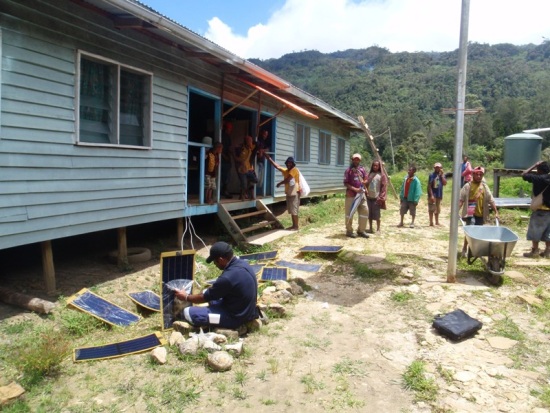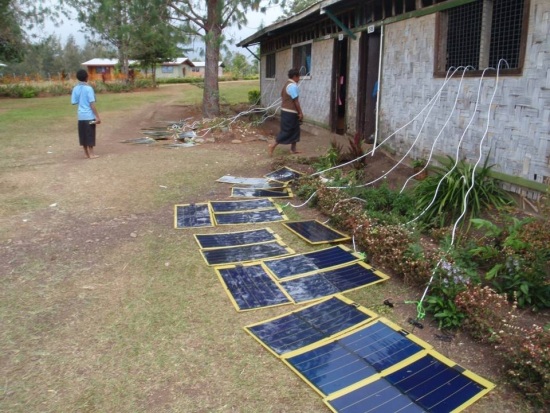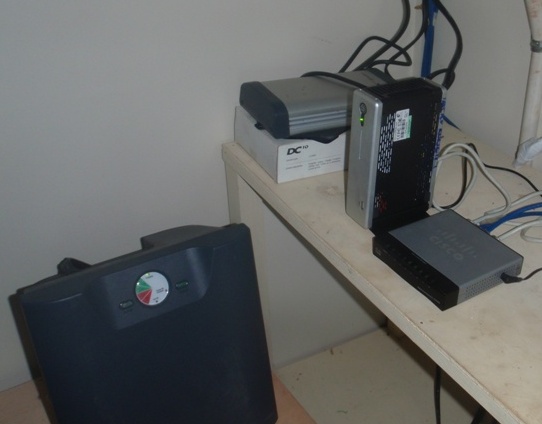Resumen en español al final del artículo
In remote areas of Papua New Guinea (PNG), as is the case with much of the rural Pacific Islands, grid electricity is rare and rural schools often have none available at all. Even where a grid exists, power costs are very high, for instance in Solomon Islands the kWh unit charges are over USD 80c, and generator fuel once transported to rural areas can exceed USD 10 per gallon in some cases.

Gary Laka of PNGSDP testing DC Share systems at Tekin
So when we considered a project to pilot OLPC in eleven very remote primary schools in PNG we were aware that power would be a major issue. Even with the low consumption of the XO-1 laptops, applying the saturation principle leads to hundreds of these devices needing charging every day - at the school mostly, as the homes may also have no electricity.
I have designed and installed many solar power systems for individuals, communities and schools in the Islands over the years. Typically this involves arrays of crystalline silicon solar panels, regulators, banks of massive batteries and inverters. Recently we have seen a lot of progress in this area, especially with high intensity LED lighting, which greatly helps balance the energy and financial budgets. However, these "centralised" fixed installations don't lend themselves to a 1:1 laptop project in such schools easily.
Firstly, if one comes to school with a flat laptop battery (because you don't have power at home) you need to be able to sit down and start using the laptop in class immediately. This means that you have to plug it in to something whilst being able to use it. However, the classroom you are sitting in might be a very ramshackle affair, with corrugated iron walls and lots of rodent activity. Desks may be only barely recognisable as such. It would be quite a job to safely wire up such an environment with AC power outlets available to 40 youngsters.

The DC Share system in use - outside the classroom
Secondly, the utility represented by the large centralised solar power system, with readily available AC power, has not been lost on the teachers and people living nearby. Perhaps the mobile network provider has just established a tower in the vicinity, and people suddenly have a need to charge their newly acquired handsets. Before long, an extension cable can be snaking its way from the classroom block at many hours of the day and night. It is not long before the inverter refuses to come on, and the batteries no longer hold charge. OLPC have worked with their industry partners including Belkin, Goldpeak, and RCAL to design a novel solution to these challenges. As is the case with many successful innovations, it is beautifully simple in nature. As is implied by the name DC Share, the system shares DC power directly from solar panels to laptops with no centralised infrastructure, inverters or battery banks needed. This is made possible because the power supply electronics in the XO accept a wide range of fluctuating voltages through the DC input socket - effectively each has its own charge regulator built in.

School server with power supply - Yenkenai Primary School, North Fly, PNG
The DC Share system consists of an 8m cable with connections for up to four solar panels on one end, and short leads with power connectors for up to four XOs on the other. Typically, 15 or 20W flexible (thin film) solar panels are used - we used 15W panels produced by Goldpeak. These are laid out in the sunshine outside the classroom (or on the roof) and fed through open windows to the students in the classroom. This encourages arranging students in small groups. The panels might be stored in the classroom and the children can be organised to get them out in the morning, arrange them as needed, and replace them after school.
David Leeming is an ICTD activist from the Solomon Islands
Resumen en español: David Leeming explica como se ha utilizado el DC Share de OLPC en el proyecto de OLPC en Papúa Nueva Guinea. El DC Share facilita el uso de paneles solares como fuente de electricidad para los XO en escuelas. Así es posible utilizar las maquinas en entornos donde hay poca infraestructura electrica.

